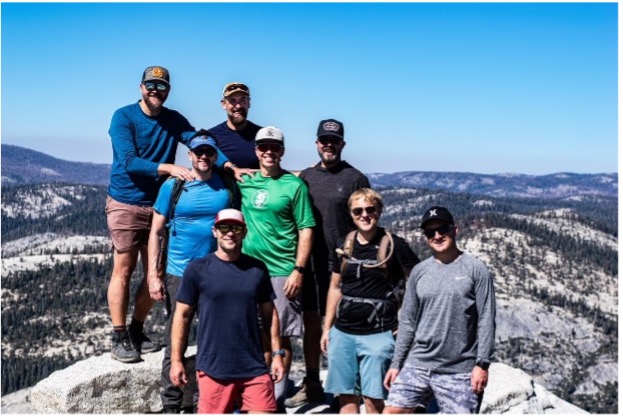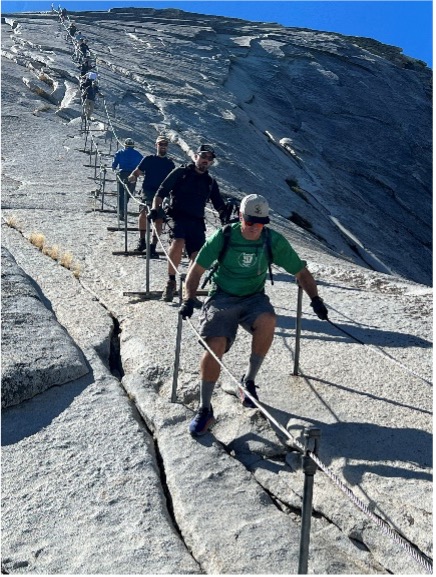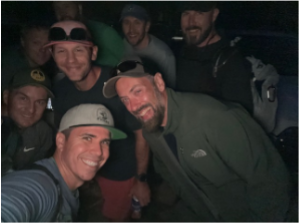
Why doing something hard is important
In Michael Easter’s book, The Comfort Crisis: Embrace Discomfort to Reclaim your Wild, Happy, Healthy Self, he covers the value of accomplishing difficult, physical challenges and tasks and describes the Japanese Shinto practice of ritual purification called Misogi. The practice, which roughly translates to a “purifying water ritual,” involves the pilgrimage to an icy waterfall, where the person would have to go through the ordeal of traveling to and from the waterfall and experiencing the cleansing in near freezing temperatures.
There are two basic rules for the practice of doing something difficult in nature:
1. Make it hard, and
2. Don’t die
The objective is to execute one extremely difficult task per year. Ideally, it’s something that you have doubts you can achieve and then go out and achieve it anyway. The idea being that you have one day where you do something really hard, which opens your mind to accomplishing difficult tasks the other 364 days a year.
 This year’s test involved the hike from Yosemite’s valley floor to the top of Half Dome. The route we took this time involved more than 47,000 steps and covered more than 20 miles. The hike is certainly challenging, as Misogi should be. And, it was an all-day affair, requiring a combination of physical fitness, preparation and planning, grit, and some luck. This was my fifth time doing the hike, so the walk itself may not have been the Misogi for me; however, there were a few wrinkles that forced me to stretch my mindset and achieve a new goal in nature, which is the objective of the annual test.
This year’s test involved the hike from Yosemite’s valley floor to the top of Half Dome. The route we took this time involved more than 47,000 steps and covered more than 20 miles. The hike is certainly challenging, as Misogi should be. And, it was an all-day affair, requiring a combination of physical fitness, preparation and planning, grit, and some luck. This was my fifth time doing the hike, so the walk itself may not have been the Misogi for me; however, there were a few wrinkles that forced me to stretch my mindset and achieve a new goal in nature, which is the objective of the annual test.
Select the Misogi
 As stated earlier, a Misogi needs to feel scary or on the verge of unachievable to you. Easter claims you should seek out something that you perceive has a ~50% success rate. As stated earlier, I have done this hike before, but I had always gone with others who were very experienced. This time, I was the only person in our group of eight who had previously completed this hike and had experience with this challenge. Each of the other members of our crew had been doing some preparatory hikes to test equipment and poles, but this type of challenge was not a norm for any of us.
As stated earlier, a Misogi needs to feel scary or on the verge of unachievable to you. Easter claims you should seek out something that you perceive has a ~50% success rate. As stated earlier, I have done this hike before, but I had always gone with others who were very experienced. This time, I was the only person in our group of eight who had previously completed this hike and had experience with this challenge. Each of the other members of our crew had been doing some preparatory hikes to test equipment and poles, but this type of challenge was not a norm for any of us.
Assemble a Team
This trip was the brainchild of a new friend, Chris. And Chris (whom I learned is a project manager) did an outstanding job of preparing the entire crew and selling everyone on this mission, which was a bucket-list type challenge for him to complete on his 40th birthday.
For context, Yosemite now severely limits the number of hikers who can ascend “the cables,” which are the final stage of the Half Dome hike, by requiring that you acquire a permit for the specific day you would like to ascend. The permits are non-transferable, so if you have a rain event, lightning, or high winds, you are out of luck. That being said, even with the much more limited numbers of people going up or down Half Dome each day, there is still an element of danger to the hike. There are slippery granite surfaces, there is little to no safety railing throughout the hike, there is only one set of cables that are shared by all people going up and going down, and there are no safety nets adjacent to the cables themselves.
For Chris and the crew to get the permits, they had to wake up at zero dark thirty in March to log on to the Yosemite website and secure the two permits (which allow 4 people each). The crew secured two permits for October 5th (Chris’s 40th birthday) and then they had to build the team.
 The group was comprised of me, five other Livermore dads and two buddies visiting from Phoenix (8 total). In the two months leading up to the hike the Livermore group did a few local test hikes to prepare for the big day. The Arizona crew also did some hikes to prepare and although I hadn’t been able to get back into hiking, I had ramped up my own beach volleyball training and started playing tournaments again, which typically involves 6– to 10-hour days in the sand walking 20,000 to 30,000 steps.
The group was comprised of me, five other Livermore dads and two buddies visiting from Phoenix (8 total). In the two months leading up to the hike the Livermore group did a few local test hikes to prepare for the big day. The Arizona crew also did some hikes to prepare and although I hadn’t been able to get back into hiking, I had ramped up my own beach volleyball training and started playing tournaments again, which typically involves 6– to 10-hour days in the sand walking 20,000 to 30,000 steps.
As we made our final arrangements, my Misogi was revealed: it was to help seven other people safely get up and down the hill. I knew two members of our party well and did my best to share wisdom while trying to avoid coming off like a know it all.
Plan the Work and Work the Plan
We agreed on an early start and set our alarms for 5:00 am to depart Curry Village by 5:45 am. When we started walking, we set an up-tempo pace to ensure we could get to Vernal Falls before construction on the Mist Trail started at 7:00 am. When all eight of us got up past Vernal Falls ahead of the construction crews, I felt good confidence that with good strategy and a little luck, we would all be able to summit the cables and make our way down again.
 To get a group of people though the hike, it’s important to set a steady pace and help people manage water, food intake, and keep spirits up. It’s also important to appreciate the time in nature. We stopped and brewed coffee above Vernal Falls. We stopped for lunch near Little Yosemite Valley and paused for snacks when we hit the switchbacks. We also stopped at several of my favorite spots along the way for photos, which are sprinkled throughout the newsletter.
To get a group of people though the hike, it’s important to set a steady pace and help people manage water, food intake, and keep spirits up. It’s also important to appreciate the time in nature. We stopped and brewed coffee above Vernal Falls. We stopped for lunch near Little Yosemite Valley and paused for snacks when we hit the switchbacks. We also stopped at several of my favorite spots along the way for photos, which are sprinkled throughout the newsletter.
By 11:30am, we reached the final staircase above the tree line, which is where they historically check permits, and represents the most physically taxing part of the hike. You basically walk ¾ of a mile up craggy granite steps and then scramble for about 400 yards up a very vertical pitch on round granite rock.
It was at this point that my tendency for positive feedback and encouragement took a bit of a toll on the group. I knew they needed motivation, but after telling the crew, “You’re al…most… there!”, one too many times (about 40 minutes before they were actually there), I caught some good-natured ribbing and earned the new nickname “Y.A.T.” (short for “you’re almost there”). It was at that point I realized I’d become a little more cheerleader-like than was probably productive during a particularly grueling time of the hike. I was reminded of the Stockdale Paradox, where Admiral James Stockdale said, “You must never confuse faith that you will prevail in the end—which you can never afford to lose—with the discipline to confront the most brutal facts of your current reality, whatever they might be.” Sometimes as a leader, it’s important to avoid being the vocal cheerleader, and instead focus on being a calming physical presence or someone who can support others as they process the physical challenge in their own way.
Just one hour later, around 12:30, we reached the famous saddle and prepared to climb the cables. By that time, the group was doing pretty well physically, but the temperature was now in the 70’s (hotter than anticipated), we had one person who had consumed all 3 liters of his water and another who’s calf had started cramping.
We had three members of our crew who were nervous about ascending the cables (which is legit considering how vertical they are, how physically taxing the rest of the journey had been, and that someone had recently passed away after falling from the cables), but fortunately, we all made it up safely and smoothly. After hanging out for about an hour up top, we went back down the cables, and made our way back home.
Don’t Die – You’re Almost There
 The trip back down was long and slow. By this time, we had one person who was suffering from blisters, all of us were pretty worn down and at least two of us were fighting cramps. We managed to get down the switchbacks without incident (I’ve rolled an ankle on the loose rocks and tree roots before) by slowing our pace and agreeing to stop at the Merced River near Little Yosemite Valley to filter water and for a quick swim in the nearly freezing cold river.
The trip back down was long and slow. By this time, we had one person who was suffering from blisters, all of us were pretty worn down and at least two of us were fighting cramps. We managed to get down the switchbacks without incident (I’ve rolled an ankle on the loose rocks and tree roots before) by slowing our pace and agreeing to stop at the Merced River near Little Yosemite Valley to filter water and for a quick swim in the nearly freezing cold river.
At the end, rather than kill our knees going down hundreds of stairs at Vernal Falls again, we took the longer, but physically easier hike down the John Muir Trail and made it back to our cars at 6:45 pm, 13 hours and 20.5 miles later.
Once we made it to the valley floor, we took a quick photo, rushed to our cars, and made it back in time to enjoy an incredible pizza dinner with our families in Groveland.
The key lessons from this Misogi:
- Do Something Hard – The Half Dome hike is a beautiful test of both your brain and your body. Each time I go, I appreciate new elements to the hike and observe incredible beauty along the way.
- Take a Leadership Role – This was a new one for me on the Half Dome trip. I’ll admit it was super rewarding to achieve a Misogi by enabling others to do so. I felt a different sense of “ownership” and “responsibility” this time, which I had never previously experienced. It gave me a new relationship to the hike, and I can understand why my friend Griff has helped hundreds of others complete the hike on their “rookie” trips.
- Stay Positive-ish – As stated earlier, I (fairly) caught a bit of flack from the group for being a little Pollyanna-ish during the toughest part of the hike. As Admiral Stockdale said, its critical to remain positive – but also to stay grounded. My (incorrect) memory was that it took ~20 minutes to get through the super challenging part of the hike, so when I told the group they were almost there… I genuinely believed it. The problem was they had 45 more minutes to go. While it was an honest mistake and came from a place of great intentions, it is an important reminder to stay positive, but also stay grounded. Don’t be a Y.A.T.
- Celebrate Victories with Loved Ones – One of my favorite moments was calling my wife and daughter from the top of the hill. It’s so random and cool that the best cell coverage in the park is on the top of a famous rock! I also brought a Honeycrisp apple and Sour Patch Kids to share while on top of Half Dome. There is literally no better snack than a little treat you bring yourself for completing that hike.
- Enjoy the Thinking Time – I am currently working on a re-branding effort and thinking longer term about OrgMetrics as a business. While it’s been an incredible year, investing time in a challenging physical challenge also gives me time to just process and think. It helps me with perspective and exploring where I want to go as a leader. This Misogi reminded me that I need to do this more than once every three years and also to just walk in nature and be present without distracting myself with a podcast, audiobook, or music as I walk. I’m missing out on opportunities to create, incubate ideas, and properly think.
 I encourage you to follow Chris and our group and create a Misogi for yourself. Just remember… do something hard and don’t die! I also recommend you do that thing in nature, which helps you get a little dirty, and to celebrate the attempt with friends and family. It’s way more rewarding when you do.
I encourage you to follow Chris and our group and create a Misogi for yourself. Just remember… do something hard and don’t die! I also recommend you do that thing in nature, which helps you get a little dirty, and to celebrate the attempt with friends and family. It’s way more rewarding when you do.
– Rob
Rob Reaugh is President of OrgMetrics LLC. He facilitates the City and County of San Francisco Collaborative Partnering Steering Committee and currently works with San Francisco International Airport, San Jose International Airport, BART, Caltrans, and others. He holds a Masters’ Degree in Alternative Dispute Resolution.
For more information please contact Rob Reaugh, RobReaugh@Orgmet.com / (925) 487-2404 (cell), or OrgMetrics, (925) 449-8300.


